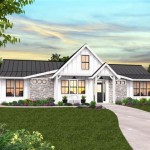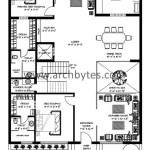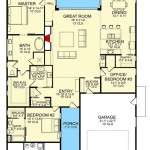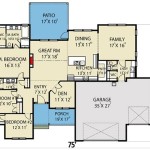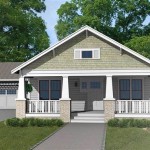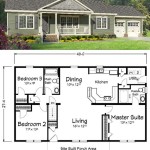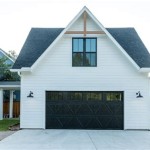House Floor Plans With In-Law Suite: A Comprehensive Guide
The escalating cost of living, coupled with changing family dynamics, has fueled a growing demand for housing solutions that accommodate multiple generations under one roof. House floor plans with in-law suites offer a practical and often financially advantageous solution. These suites, also referred to as accessory dwelling units (ADUs), provide private living spaces within a larger home, fostering independence while maintaining proximity and shared resources. This article will delve into the various aspects of house floor plans with in-law suites, encompassing design considerations, legal implications, and suitability for different family structures.
An in-law suite is typically a self-contained living space integrated into the main residence. It's more than just an extra bedroom; a true in-law suite generally includes a private bedroom, bathroom, living area, and kitchen or kitchenette. The degree of separation from the main house is a critical design element, affecting privacy and the perceived independence of the suite's occupants. The size and features of the suite can be tailored to the specific needs and preferences of its intended residents, ranging from a compact, functional space for a single occupant to a more spacious and luxurious apartment suitable for a couple.
Key Point 1: Design Considerations for In-Law Suites
Designing an effective in-law suite requires careful consideration of several factors, including accessibility, privacy, and functionality. Accessibility is paramount, particularly if the suite is intended for elderly or disabled individuals. Features such as wider doorways, grab bars in the bathroom, and ramped entrances can significantly improve usability and safety. Universal design principles should be incorporated wherever possible to ensure the suite is adaptable to changing needs.
Privacy is another critical aspect of in-law suite design. A separate entrance is highly desirable, allowing occupants to come and go without disturbing the main household. Soundproofing measures, such as insulated walls and floors, can minimize noise transmission between the suite and the main house, enhancing the privacy and comfort of both areas. The placement of windows and doors should also be carefully considered to maximize natural light while maintaining visual privacy.
Functionality refers to the efficient and practical layout of the suite. The kitchen or kitchenette should be equipped with essential appliances, such as a refrigerator, stove, and microwave, and sufficient counter and storage space. The living area should be comfortable and inviting, providing a space for relaxation and entertainment. The bathroom should be designed with accessibility in mind, and the bedroom should be large enough to accommodate a bed, dresser, and other essential furniture.
Several architectural styles lend themselves well to in-law suite integration. Ranch-style homes are particularly suitable due to their single-story layout, which facilitates accessibility. Two-story homes can accommodate in-law suites on either the ground floor or the second floor, depending on the specific needs of the occupants. Basement suites are also a common option, although they may require additional work to ensure adequate natural light and ventilation. Converting an existing garage into an in-law suite is another possibility, but this may require significant structural modifications and adherence to local building codes.
Integrating the in-law suite aesthetically with the existing house is also important. The architectural style, materials, and colors used in the suite should complement those of the main house to create a cohesive and harmonious design. Landscaping can also be used to enhance the privacy and appeal of the suite, creating a distinct outdoor space for its occupants. Careful planning and attention to detail can result in an in-law suite that is both functional and aesthetically pleasing, seamlessly integrated into the overall design of the home.
The size of the in-law suite should be determined based on the needs and preferences of its intended occupants. A small, studio-style suite may be sufficient for a single individual, while a larger suite with multiple bedrooms and living areas may be required for a couple or a family. The layout of the suite should be designed to maximize space utilization and create a comfortable and functional living environment. Consideration should be given to storage needs, and built-in storage solutions can be incorporated to optimize space.
Key Point 2: Legal and Regulatory Considerations
Before embarking on the construction or renovation of an in-law suite, it is crucial to thoroughly investigate local zoning regulations, building codes, and homeowner association rules. Many municipalities have specific requirements governing the construction of accessory dwelling units, including restrictions on size, location, and occupancy. Failure to comply with these regulations can result in fines, legal action, and even the forced removal of the suite.
Zoning regulations often dictate the permissible size and location of ADUs on a property. Some municipalities may restrict the size of the ADU to a certain percentage of the main house's square footage, while others may require it to be located within a specific setback distance from property lines. Occupancy restrictions may also be in place, limiting the number of people who can reside in the ADU. It is essential to consult with the local zoning department to determine the specific regulations applicable to the property.
Building codes govern the structural integrity, safety, and energy efficiency of buildings. In-law suites must comply with all applicable building codes, including those related to electrical wiring, plumbing, ventilation, and fire safety. Obtaining the necessary building permits is crucial to ensure that the construction or renovation work meets these standards. Failure to obtain permits can result in costly fines and delays.
Homeowner association (HOA) rules may also restrict the construction or use of in-law suites. Some HOAs may prohibit ADUs altogether, while others may impose restrictions on their size, design, or occupancy. It is essential to review the HOA covenants and restrictions carefully before proceeding with any construction or renovation work. Seeking approval from the HOA board may be required before commencing the project.
In addition to zoning regulations, building codes, and HOA rules, there may be other legal considerations to take into account. For example, if the in-law suite is intended to be rented out, the landlord must comply with all applicable landlord-tenant laws. These laws govern issues such as lease agreements, security deposits, and eviction procedures. It is advisable to consult with an attorney to ensure compliance with all relevant legal requirements.
Property taxes may also be affected by the addition of an in-law suite. The assessed value of the property may increase, resulting in higher property tax bills. It is essential to factor in these potential tax increases when evaluating the financial feasibility of adding an in-law suite. Consulting with a local tax assessor can provide an estimate of the potential impact on property taxes.
Key Point 3: Suitability for Different Family Structures and Financial Benefits
In-law suites offer a versatile housing solution that can be adapted to suit a variety of family structures. They are particularly well-suited for multigenerational families, providing a private living space for aging parents or adult children while allowing them to remain close to their family. The suite can also serve as a comfortable and convenient space for visiting relatives or friends.
For families with young children, an in-law suite can provide a valuable source of childcare support. Grandparents residing in the suite can assist with childcare duties, allowing parents to work or attend to other responsibilities. The suite can also serve as a playroom or a dedicated space for children's activities.
In-law suites can also be used as rental units, generating additional income for homeowners. Renting out the suite can help to offset mortgage payments, property taxes, and other housing expenses. However, it is essential to comply with all applicable landlord-tenant laws and regulations when renting out the suite. Screening potential tenants carefully and establishing clear rental agreements are crucial to ensuring a positive and mutually beneficial landlord-tenant relationship.
The addition of an in-law suite can also increase the resale value of a home. Many homebuyers are attracted to the flexibility and potential income-generating opportunities offered by ADUs. A well-designed and maintained in-law suite can be a valuable selling point, making the home more attractive to a wider range of potential buyers.
Beyond the direct financial benefits, in-law suites can also provide significant social and emotional advantages. They can foster stronger family bonds, provide support for aging parents, and create a sense of community within the home. The presence of extended family members can enrich the lives of all occupants, providing companionship, assistance, and a sense of belonging.
However, it is essential to carefully consider the potential challenges associated with multigenerational living. Differences in lifestyle, values, and expectations can lead to conflicts and misunderstandings. Open communication, mutual respect, and clearly defined boundaries are essential to maintaining a harmonious living environment. Regular family meetings can provide a forum for discussing issues, resolving conflicts, and ensuring that everyone's needs are being met.
Ultimately, the decision of whether to add an in-law suite to a home is a personal one that should be based on a careful assessment of the family's needs, financial situation, and lifestyle preferences. Thoroughly researching local regulations, consulting with professionals, and carefully planning the design and construction of the suite are crucial to ensuring a successful and rewarding outcome.

In Law Suite Plans Give Mom Space And Keep Yours The House Designers

House Plan 65862 Tuscan Style With 2091 Sq Ft 3 Bed 2 Bath 1

Southern Style House Plan With In Law Suite

Homes With Mother In Law Suites

House Plans With In Law Suites Houseplans Blog Com

Updated Farmhouse Style House Plan 7382 Pinecone Trail

Exquisite Mountain Modern Home Plan With In Law Suite And 4 Car Garage 95104rw Architectural Designs House Plans

5 Bedroom Ranch House Plan With In Law Suite 2875 Sq Ft Plans One Story New

Find The Perfect In Law Suite Our Best House Plans Dfd Blog

Front Side View House Plans With A Separate In Law Suite

